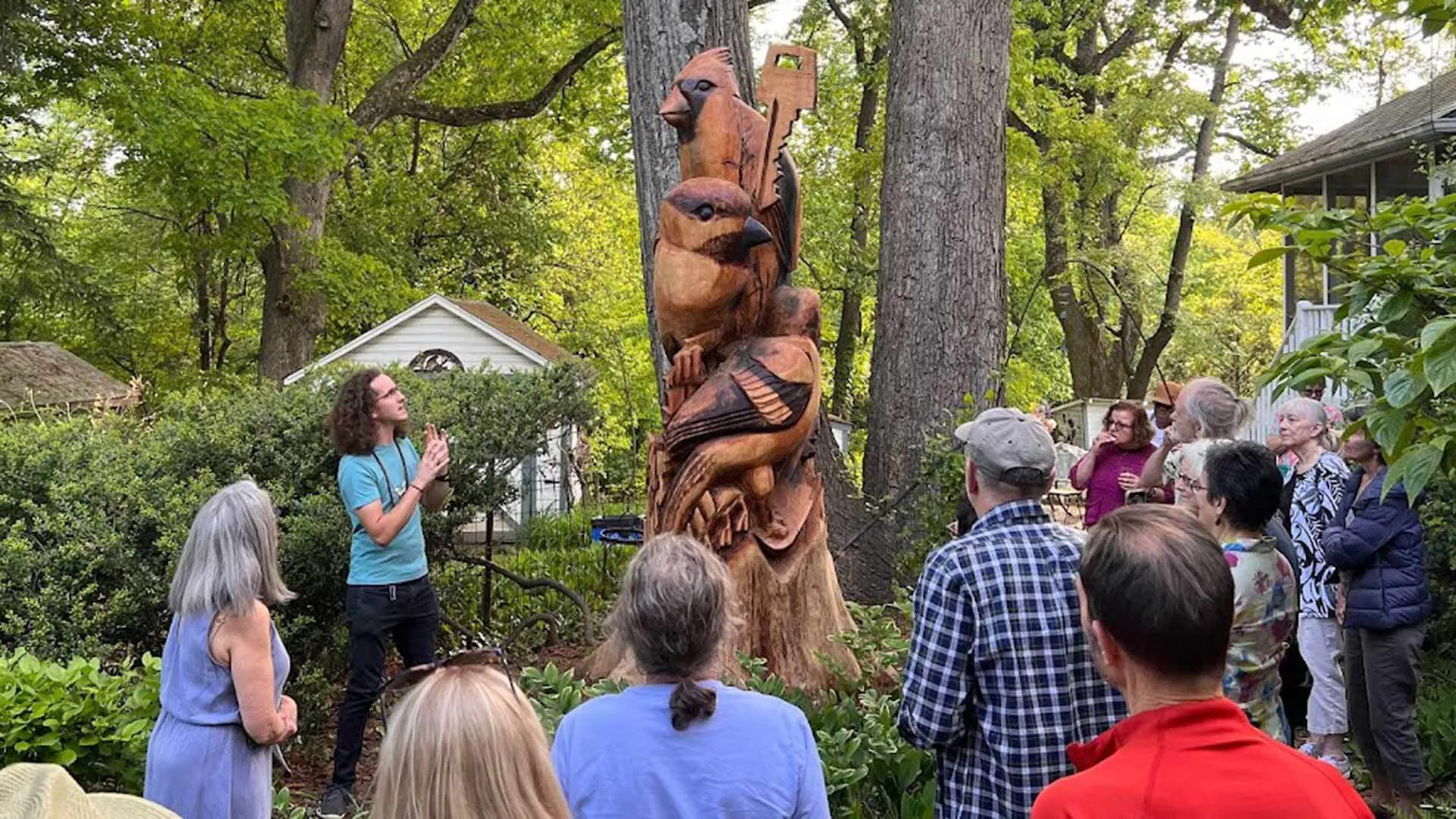- May 07, 2024
- By Karen Shih ’09
In the quiet woods of Brookville, Md., where deer peer out from behind trees and red-brick remnants of long-defunct Girl Scout campsites dot the landscape, a chainsaw roars into action.
The powerful buzz usually signals destruction: the swirl of sawdust in the air, the crash of branches hitting the ground.
But in Colin Vale’s gloved hands, the chainsaw becomes a precision tool, giving new life to dead sycamores and oaks as he transforms them into works of art. His oversized wood sculptures have sprouted throughout the D.C. metro area, depicting everything from a two-headed giraffe in a Colesville front yard to a pine cone and acorn rising out of intertwined maple seeds at Brookside Gardens in Wheaton.

“Carving Colin,” as Vale ’13 has dubbed himself, has a yearlong waitlist for private commissions and a steady stream of public works, including his largest yet, at 20 feet tall, set to debut in late May along the Rails to Trails pathway in Mt. Airy, Md. He draws inspiration about the impermanence of life from Buddhist philosophies, which influences his work.
“I’m dying, and so is everyone else,” he said. “I wanted to use my time on earth to make the world more beautiful.”
Vale originally planned to be a mechanical engineer. But disillusioned with the government contracting jobs he saw advertised, he took a year off after graduating to travel through World Wide Opportunities on Organic Farms (WWOOF), working in a different country each month in exchange for room and board.
He cut lemongrass from rice terraces in Nepal for tea, picked pomegranates in South Africa and fished in Easter Island, Chile. The remote islands are famous for their giant head sculptures, and locals create small versions to sell as souvenirs. When Vale saw his host, Moi Moi Tuki, working on one, he asked if he could learn.
“You literally start with this triangular chunk of firewood, and you could throw that into the fire and burn it. Or put a few hours of intentionality into it, and transform it into this holy object that a family keeps for generations,” Vale said.
But when he returned to the U.S., he still wasn’t sure of his career path. He worked for a few years as a computer programmer before returning to WWOOF. That took him to a Buddhist monastery in New Mexico, where he joined a two-week silent retreat. Vale emerged with one conviction: He was going to dedicate his life to making art.
After briefly dabbling in painting and hand-carving small objects, he saw an article about a chainsaw sculptor based in Virginia named Andrew Mallon. Vale emailed him on a whim, and Mallon invited him to his studio to learn more.

“I didn’t even know how to start a chainsaw! I was very embarrassed to ask, honestly,” said Vale, who now owns multiple chainsaws, safety equipment including goggles, a respirator mask and “chainsaw chaps” to protect his legs. “But he was so encouraging. Six hours later, I left with my first chainsaw-carved bear in a log.”
During the pandemic, he started putting his projects out along the walking paths in his parents’ neighborhood in Olney, Md. Then, as Black Lives Matter protests gripped the country, he carved a giant fist and put it in front of the local post office, a bit of guerrilla art in support of the movement. Vale was disheartened when it got stolen—but when that made the local news, he got his big break.
Brookside Gardens contacted him about a stump just outside of its greenhouses, and Vale got his first paid gig. He learned a lot about managing his time, which tools worked best (electric chainsaws, while environmentally friendly, are slow) and how to mesh a client’s ideas with his own. It was worth it, because the sculpture became his calling card, leading to commissions across the area.
“He puts a lot of energy and time and thought into his designs,” said Colter Burkes, senior urban forester with Montgomery Parks, which hired Vale last year to create a bench out of the centuries-old Linden Oak after it died. Flanked by a bison in a nod to Maryland’s history, the seat is “a great way to memorialize the tree in a different form and still be in the community where it was growing.”
Working with wood, rather than longer-lasting rock or metal, means Vale’s art is relatively ephemeral. It won’t last more than a few decades. That’s what he likes about it.
“The artistic vision is for it to rot,” he said. “It’s circular and regenerative: The wood becomes soil and sprouts fresh plants,” creating new life and offering endless new artistic possibilities.

Vale shares one of his sculptures featuring a cardinal, chickadee and Baltimore oriole.
Topics
People